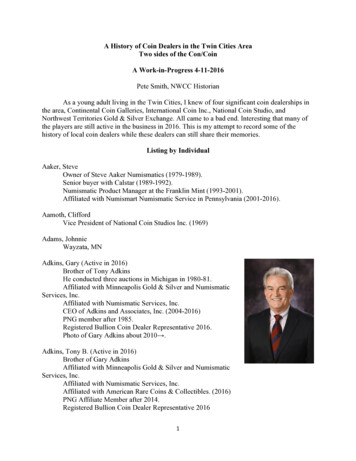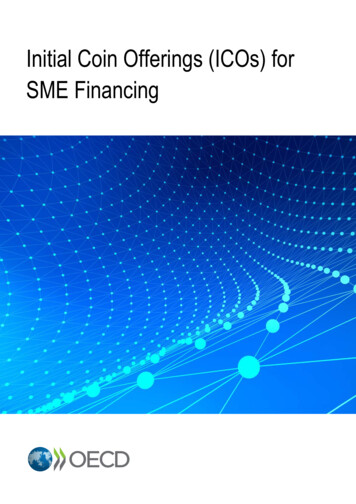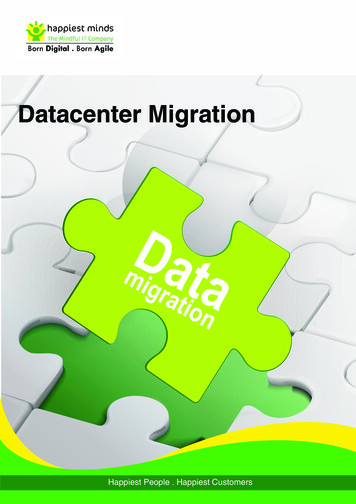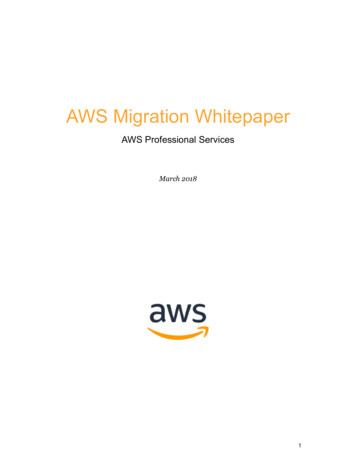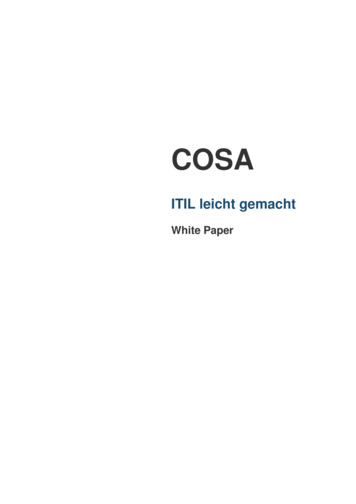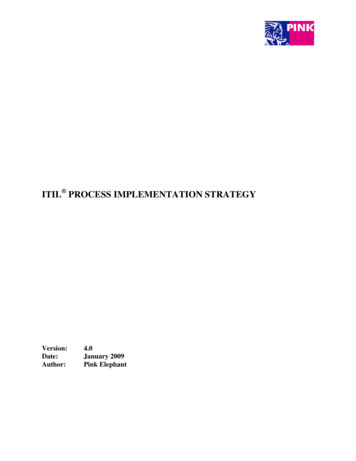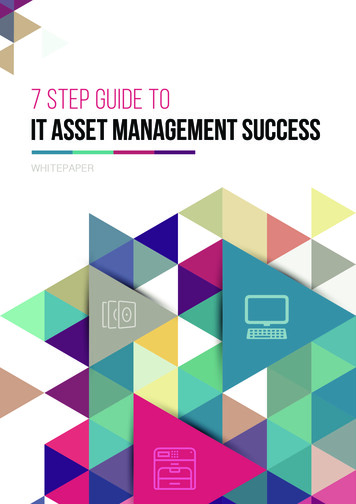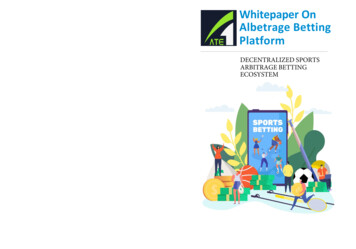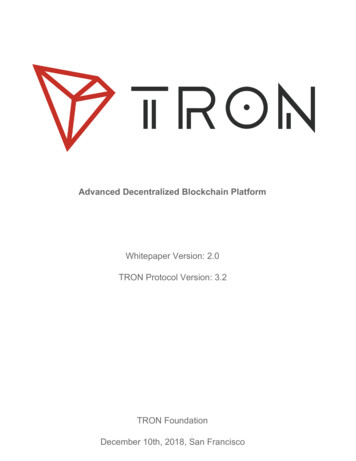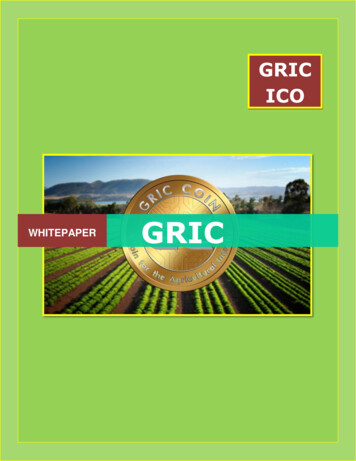
Transcription
GRICICOWHITEPAPERGRIC
GRICInitial Coin OfferingWHITEPAPERContents: Abstract Industry and Market Overview Problem Solution: Our Model Initial Coin Offering (ICO) The Gric (GC)Token Road Map and Milestones Technology Marketing Plan Financial Plan Team ReferencesGRIC1
AbstractThis whitepaper describes how GRIC is going to disrupt and transformagriculture and farming practice with the launch of a smart blockchainbased GRIC Project for agriculture, with a particular focus on Africa. It willhave positive impact on the overall cryptocurrency market as well. GRICaims to create a decentralized open source blockchain based agricultureplatform, enabling the common investors and farmers to benefit from newtechnologies.The World Bank estimates show that African food market will be worthUS 1 trillion by 2030, up from the current US 30-50 billion. The majorproblems afflicting the agriculture and food market include lack of finance,lack of standardization in processing and packaging, counterfeiting or foodfraud. The Gric Coin project is set up to solve the aforementionedproblems,The Gric Coin project aims to create a brand that will be a benchmark inthe agricultural industry, remove imitation on food production/supply, bringabout transparency with the aid of blockchain, and create a vehicle forpeople to invest on real life agriculture and earn reward on theirinvestments.The Gric Coin project is divided into three major parts: 1. The Farm Project,2. The Coin Utility Project, and Service Adoption.Our FarmPartner.ng platform lists farm projects with their individual totalcost of project, and the percentage return on investment, etc. It helpsinvestors make an investment decision on the farm project of their choice.When fund is collected for a farm project, our dedicated farmers will do allthe hard work, and at the agreed time pay back to investors their initialinvestment and the agreed return on investment.We will focus on the high potential parts of the agricultural production valuechain like organic farm produce and GM foods for better earningsprospects.Through our Pre-ICO and ICO, we aim to raise funds between 10,000,000and 25,000,000 for our agricultural and farming project. The GRIC PreICO and ICO sale will start in the second quarter of 2018. 70% of all coinsGRIC2
are available for purchase during the ICO. Awesome crowdsale bonuswould be available during the ICO, especially Pre-ICO.GRIC Token is built on the Ethereum blockchain. Gric token is built on thebest crypto platform ERC-20 (Ethereum platform). That means fasttransactions, very low fees, and the unlimited growth possibilities.Ethereum is an open-source project which allows creation of smartcontracts and provides users with a secure and fast transaction system.GRIC will implement a comprehensive plan for marketing. We are planningmultiple approaches of digital marketing such as banner ads, pressreleases, signature campaigns and social media. We will list our ICO on theleading cryptocurrency exchanges.GRIC has a pragmatic financial plan as a part of the overall strategy. In itsoperations, GRIC will focus on the bottom-line from the very beginning toachieve the profitable growth and sustainability. The biggest chunk of fundsraised would be invested in buying 1000 acres of land for farming.The GRIC team comprises of highly experienced and qualifiedprofessionals. The management has a great depth and breadth ofexposure and hands-on experience across various domains in agriculture,farming, food processing, blockchain technologies, cryptocurrency/digitalcurrency space, finance, marketing, etc.We will pay about 20% of Gric Coin project profit to our token holders on aset period every year.GRIC3
Industry and Market OverviewAfrica has about 51 million farms of which about 80% are smaller than 2acres in size, as per the research study conducted by Lowder, Skoet &Raney in 2016. Most of these farms are poorly managed due to lack offinance, and in most cases do not have the facilities to process theirproduce. Consequently, they end up selling their produce with very lowmargin to the big farms or the industries that process these items and makemore profit from it.The African agricultural market is like a virgin market waiting to be tapped.According to Africa Agricultural Status Report 2017, the African foodmarket continues to grow at a robust basis. The World Bank estimatesshow that it will worth US 1 trillion by 2030, up from the current US 30-50billion. This projected growth is so large that any firm that goes into farmingwith the right strategy will have very big opportunities for growth, expansionand profit making.The African continent holds the world's largest proportion of agriculturalland with 1.2 million hectares of land, as per telegraph.co.uk.Annually, Africa imports food worth over 35 billion, and this estimate isexpected to rise to 110 billion by 2025. Most of the food items importedare the ones that can be processed locally. But this needs properresources and facilities with commensurate investments.Businesses are waking up to the opportunities presented by a rapidlygrowing food market in Africa, that may be worth more than US 1tn eachyear by 2030 as imports are substituted with high-value locally-producedfood as per the Africa Agriculture Status Report. According to the report,agriculture will be Africa’s quiet revolution, powered by the smartinvestments in the food system.Dr Agnes Kalibata, president of the Alliance for a Green Revolution inAfrica (AGRA), which commissioned the study, said: “Africa has the latentnatural resources, skills, human and land capacity to tip the balance ofpayments and move from importer to exporter by eating food made inGRIC4
Africa. This report shows us that agriculture involving an inclusivetransformation that goes beyond the farm to agribusinesses will be Africa’ssurest and fastest path to that new level of prosperity.” “Smart support isjust as important as scale of support for Africa’s highly-diverse group offarmers and agribusinesses. To step up their game, businesses needsassistance tailored to distinct groups of viable small farms andagribusinesses at different development stages, rather than blanket supportfor all,” added Kalibata.Africa holds a good potential for agriculture and farm sector development.The arable land in Africa has been growing at higher rate as compared toother regions of the world, as shown below:This statistic represents areas of arable land in selected regions of theworld (in million hectares), comparing the years 1961, 1991 and 2007.Though, Asia has the maximum arable land, but Africa has shown a highergrowth rate of arable land.GRIC5
We will focus on the high potential parts of the agricultural production valuechain as shown below:For instance, we will look at the rapidly emerging high value growthopportunities like organic farm produce and GM foods for better earningsprospects.The GM foods are being sold at better rate with a higher value creation forthe farming community. Many advanced countries are now focusing on theGM crops, led by USA as revealed by the following chart:GRIC6
This statistic shows the area of genetically modified (GM) crops worldwidein 2017, by country (in million hectares). It shows the biggest producers ofgenetically modified (GM) crops in 2017, based on planted acreage.Some countries in Latin America have successfully adopted the GM foodcrops, such as Brazil, Argentina, etc. In Brazil, GM crops were cultivated onan area of about 50.2 million hectares in 2017.GRIC7
The cryptocurrency marketThe cryptocurrency industry has been revolutionary and trailblazing in itsformative years. The number of active cryptocurrencies has crossed thelandmark of 2000. The total market capitalization of cryptocurrencies isabove the 250 billion mark. The total value of daily transactions in thecryptocurrencies is around the 10 billion mark. The cryptocurrency markethas shown a meteoric rise in the value and volume, particularly since 2016.The biggest challenge to cryptocurrency use is the unstable nature of itsprices. The cryptocurrency market saw a great increase in its market capbetween 2016 and 2017. But, there have been large fluctuations in theirvalues since December 2017. The price of Bitcoin has risen astronomicallyover past years with a great deal of volatility. Bitcoin prices, for instance,recently declined from 19,500 to 6,500 over a period of four months.However, the cryptocurrency markets have exhibited some sort of stabilityin the last couple of months. This is a positive for the new ICOs andcryptocurrencies, as well as the ICO founders and the entrepreneurs.GRIC8
ProblemThe agriculture and farm produce market is one of the oldest markets inalmost all the countries around the world. But, in most of the countries, it isthe market that has remained a primitive one, despite great technologicaladvances that have transformed other markets like metal market, oil/energymarket, etc.The major problems afflicting the agriculture and farm produce market invarious countries, particularly in the African countries, are as follows:Lack of finance for agricultural projectsAccording to Africa Agricultural Status Report 2017, the African foodmarket continues to grow at a robust basis. The World Bank estimatesshow that it will worth US 1 trillion by 2030, up from the current US 30-50billion. This translates into a high growth rate on annual basis. To achievethe projected growth, corporate bodies and individuals will have to investhuge sums in the agricultural sector. But the requisite investments or fundsare drastically lacking.Lack of standardization in processing and packaging of agriculturalproduceAccording to world health report, as the food production in Africa increases,there will be a critical need for standardization of agricultural produce in thecontinent. For instance, one of the most common agricultural produce inNigeria is Garri. Almost every adult in Nigeria eat Garri at least once in aweek. While about 90% of adult eat it at least once a day. Though theproduce is very common, yet the issue of standardization made it veryfrustrating for people from one region of the country to buy Garri fromanother region as there is no common standard at which it's prepared andpackaged. Similar issues adversely affect almost all the food produced inAfrica.GRIC9
Lack of transparencyTransparency is essential to ensure a climate of trust and confidence thatfosters business and industrial development. Transparency givesinvestors, shareholders and stakeholders the tools they need for properaccountability from business. This accountability helps improve lives, buildtrust and increase investment. With the issues of corruption at all time highin Africa, people investing in business lack the tools needed foraccountability thereby discouraging shareholders and other stakeholdersfrom financing even the great business opportunities.Imitation and counterfeiting of processed and packaged agriculturalproduce (food fraud)One of the critical problems plaguing the agriculture and food sector inmany African countries is the food fraud including fake food items, imitationand counterfeiting of processed and packaged agricultural produce, etc.This has caused great losses including numerous deaths. For instance, inFebruary this year, 14 years old Nahima and Yayaya died after eatingbiscuits at a classmate’s birthday celebration in their school in Abuja,Nigeria. Several other children in their class were hospitalized and thepanic led to temporary closure of the school. Food fraud not only leads tocountless deaths, but also costs the global food industry over 10 billionannually as per United States’ grocery Manufacturers Association.Research by the confederation of Tanzania Industries estimated that over50% of all food items imported into Tanzania are fake. Food fraud includesusing fake and substandard materials to imitate the branded product,selling it in the market as the original product, packaging a fake product inanother brand item packaging, and other processes used in defraudingconsumers of food produce.There are other problems and constraints that are proving to beimpediments in achieving high growth and development of the agriculturaland food sector in Africa. These include: Lack of adequate and proper food processing and storage facilities. Poor agricultural practices.GRIC10
Lack of appropriate research facilities and sufficient funding.Smallholder farmers need to adapt to big changes in consumer demandand in buyer requirements (especially for safety, quality, and reliability), andmust do so in the face of far more competition than in the past. A smallshare, perhaps one-third, of smallholder farmers are in a position tocompete effectively in this new and still rapidly changing environment.Moreover, there are other problems such as inflation, and currencydepreciation and volatility, etc. that further complicate matters for theagriculture and farming sector.The cryptocurrency market saw a great increase in its market cap between2016 and 2017. But, there have been large fluctuations in their values sinceDecember 2017, which creates uncertainty to investors and users who wishto operate in a stable cryptocurrency environment. The main reason forsuch unstable outcome is the fact that a large number of cryptocurrencieshave no intrinsic value, and lack a real demand for their use.The Gric Coin project is set up to solve the aforementioned problems ofagriculture and food processing in Africa. We will also remove or reducethe cryptocurrency related problems as far as the Gric token is concerned.GRIC11
Solution: Our ModelThe Gric Coin Project is a decentralized open source blockchain projectthat is created with focus on the agricultural Sector. The Gric Coin Projectis designed by professionals and farmers, with over 35 years farming andagricultural industry experience between the
releases, signature campaigns and social media. We will list our ICO on the leading cryptocurrency exchanges. GRIC has a pragmatic financial plan as a part of the overall strategy. In its operations, GRIC will focus on the bottom-line from the very beginning to achieve the profitable growth and sustainability. The biggest chunk of funds
